

Click on a picture to enlarge - Updated on 20th February 2016
Exeter During the 'Belle Epoque' - 1900 to 1909
 Coronation
of Edward VII 1902
Coronation
of Edward VII 1902
The programme for the first day of events to celebrate the Coronation
of Edward VII. Exeter had a full programme of events across the city
for two days on 26th and 27th June, 1902.
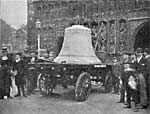 Cathedral Bells recast 1902
Cathedral Bells recast 1902
In 1901 it was decided to refurbish the bells in the Cathedral. On 24th
June 1902, to celebrate the Coronation of Edward VII, the bells were
rehung. This is the arrival of one of the recast bells outside the west
front. From the Coronation Programme.
 Thomas Moore opens 1907
Thomas Moore opens 1907
In 1907, Thomas Moore opened at 103 Fore Street - it is now the oldest
store trading in Fore Street. Photo courtesy of Thomas Moore.
 Buller Statue unveiled 1905
Buller Statue unveiled 1905
The Buller
Statue was unveiled on 7th September 1905 to a large crowd. It was
paid for through a public subscription.
The Hippodrome Theatre was opened on 2 November 1908 after the Royal Public Rooms were converted by Fred Karno into a theatre. The first performance was a variety programme with an artistic adaptation of St Mary Steps Church as a backdrop. There was also a full orchestra in the pit.
 General Buller dies 1908 General Sir Redvers Buller died at his
home in Crediton in June 1908 at the age of 68. He was buried in
Crediton. Buller gained a Victoria Cross in the Zulu War of 1879. The
photo shows guns being fired to honour the General at his funeral.
General Buller dies 1908 General Sir Redvers Buller died at his
home in Crediton in June 1908 at the age of 68. He was buried in
Crediton. Buller gained a Victoria Cross in the Zulu War of 1879. The
photo shows guns being fired to honour the General at his funeral.
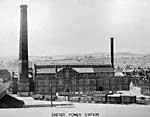
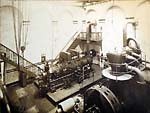 New power station 1905 Exeter's second power station was opened in 1905, ready for the
introduction of the new electric trams. It was coal powered and had a
Babcock & Wilcox boiler with a 155 ft chimney for the flue gases.
Where the railway trucks are, is now
Piazza Terracina. The Mayor, Cllr. Perry opened the station in 1905.
The works were designed from the start to allow for expansion, which
was needed in 1906 when Heavitree was added to the 'Exeter grid'. See Exeter's
Electricity Stations for
more. Both photos courtesy South Western Electricity Historical Society website
New power station 1905 Exeter's second power station was opened in 1905, ready for the
introduction of the new electric trams. It was coal powered and had a
Babcock & Wilcox boiler with a 155 ft chimney for the flue gases.
Where the railway trucks are, is now
Piazza Terracina. The Mayor, Cllr. Perry opened the station in 1905.
The works were designed from the start to allow for expansion, which
was needed in 1906 when Heavitree was added to the 'Exeter grid'. See Exeter's
Electricity Stations for
more. Both photos courtesy South Western Electricity Historical Society website
 Film Show
at the Theatre Royal 1901
Film Show
at the Theatre Royal 1901
In 1901 the Theatre Royal gave an animated
picture show that included the funeral of Queen Victoria and 60
scenes of army life. Although not the first film show in Exeter, it was
the first at the Theatre Royal. The card dates from 1905.
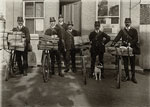 Exeter's postmen
Exeter's postmen
Six
postmen, four with
bicycles pose for a photograph. Dated around about the turn of the
century, the men were part of a service that would see up to five
deliveries a day in the city. You could arrange to meet a friend in
Deller's at three the same day by posting a card in the morning,
knowing it would arrive.
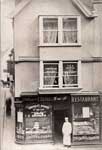
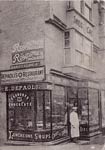 Depaoli café in the High Street
Depaoli café in the High Street
Eliseo
Depaoli is standing outside his café
‘Depaoli’s’, which he owned in Exeter until it was
lost in the blitz. Born in Switzerland, he came to Exeter in the
1870’s, as a trained pastry chef and opened his café on the
corner of Bampfylde Street. He also had a shop in Exmouth which closed
in the 1950's. The picture gives a glimpse down Bampfylde Street, now
an entrance to Princesshay from the High Street. Photos courtesy of
Suzanne Letten, great grand-daughter.
.
W G Hoskins, the historian, broadcaster and author of Two Thousand Years in Exeter was born in 1908, at 26-28 St Davids Hill. He lived in St Leonard's for many years..
The Express and Echo was launched on October 1st 1904 by its founder, James Owen. Owen went on to be Exeter's Mayor from 1914 to 1918. He was Knighted in 1918.

 Drunkard orders 1902 New
Drunkard orders 1902 New
In our 24 hour binge drinking society, it is easy to think that the problem is new. In 1902, the Chief Constable could issue a 'Notice of Orders declaring Persons to be Habitual Drunkards'.
The order, with a photograph of the offender would be given to local
pubs. If the offender tried to purchase or consume intoxicating liquor
within three years of the order, he or she could be fined up to forty
shillings (£2). Here are two orders that were given to the Bullers Arms
in Alphington Street. The names have been smudged to save embarrassment
of living relatives.

 New Civic Affairs and Politics
New Civic Affairs and Politics
The
top photograph, from 1908, shows the Sheriff of Devons escort in their
uniforms. The uniform was supplied by J & G Ross of 227/228 High
Street. The blue velvet uniforms are now kept by RAMM. The lower
photograph dates from 1906 - it shows the Exeter Parliamentary Debating
Society, probably in the Victoria Hall, arranged with opposite benches
and a speaker in the centre. In an age without television, radio and
the internet, any chance to get out was taken, and such societies were
popular with the working man.
St David's Church was consecrated on 9th January 1900 in the presence of the Mayor. Designed by W D Caroe, it was the first church in the city to have electric light installed.
Exeter's Chief Constable installed his first telephone in 1901. The first telephone exchange was established in 1883.
In July 1902 the City Council minuted that they "... resolve, that in the opinion of this Council, it is most desirable in the interests of education and commerce that the Metric System of weights & measures should be made compulsory in the British Empire..." We made fast progress then.....
Transport in the 1900's

 Standfield
and White
Standfield
and White
Facing adverts, dating from a circa 1908 guide book shows they were one
of the earliest garages in Exeter. There were few cars then, so garages
often did general engineering work as well. See the early history of early motoring
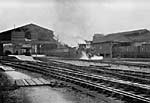 The
Cornishman 1900
The
Cornishman 1900
The Cornishman leaves St Davids Station - circa 1900. Two Great Western
Railway 4-4-0 Duke class engines are hauling a train from Penzance to
Paddington - what is known as 'double
heading'. Also see St David's GWR
Station
 Traction
Engine accident - Fore Street 1906
Traction
Engine accident - Fore Street 1906
This accident occurred on 25 April 1906 in Fore Street. It appears that
the trailer load of bricks has parted from the traction engine towing
it up the hill, and tipped over. The tram service would have been
disrupted while the bricks were cleared away.
 River Exe car crash
River Exe car crash
This accident happened towards the end of the Edwardian reign, judging
by the registration number, which indicates the car is from Manchester.
The accident has pulled a good crowd - I bet there were a few sarcastic
comments about new fangled motor cars not being as safe as the good old
horse and cart.

 Electric Trams opened 1905
Electric Trams opened 1905
At 12.31 on Tuesday 4th April 1905, the Mayor E C Perry took the
controls of the first tram of five to run along the High Street, down
Paris Street to Livery Dole and back to the Guildhall. The Mayoress was
presented with a bouquet of carnations and white heather with an
attached shoe from one of the retiring horses. Within a couple of
weeks, more than 100,000 passengers per week were being carried. The
procession was led by one of the old horse trams as far as the depot.
The 22 horses were sold on 15th April for the total of £282-8-0d.
The electric trams did not show adverts until the 1920's. See History of
transport in Exeter for more on the trams.
The postcard on the right shows a 'modern' electric tram and the
obsolete horse-drawn tram. The sender wrote 'there is a little
difference in these trams, isn't there'. Postcard courtesy of Sadru
Bhanji
 Tram
crosses new bridge 1905
Tram
crosses new bridge 1905
A tram trundles over the Exe Bridge towards Fore Street. The bridge was
specially designed to take the new 'electric' trams. At this time there
were probably fewer than twenty cars in Exeter.
 Last Car
to Heavitree 1907
Last Car
to Heavitree 1907
By 1907, postcard publishers were printing cards taking a humorous look
at the electric trams. This one is the The last car to Heavitree.
An advert appeared in the Flying Post in January 1903 for the first motor bus service in the city - "A motorbus will shortly be in Exeter for passenger traffic to and from ST ANNE'S CHAPEL and EXE BRIDGE". It went on "SHORT DISTANCES 1d - 2d ALL THE WAY". I have not established whether it ever ran.
In 1904 there were 12 private cars registered in Exeter - by 1907 there were seventy. The first car registration number for Exeter was FJ 1. By 1934, the registration FJ 8300 had been reached for Exeter's first police van. See the early history of early motoring
Shopping and Commerce in the 1900's
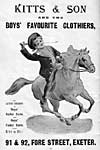 Kitts
children's clothes 1902
Kitts
children's clothes 1902
An advert for Kitt & Sons, a specialist in boys' clothing. This
advert dates from June 1902 when it appeared in the Exeter Edward VII
Coronation Programme guide. Anyone want a sailor suit....
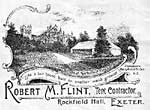 Robert
M Flint tent manufacturers 1902
Robert
M Flint tent manufacturers 1902
Robert Flint, tent contractor was based in Rockfield House from 1902.
Reid and Lee moved into the building in 1928. It is now Longbrook
House, home of the Inland Revenue. See Longbrook House - New North Road for a
full history of the site. From the
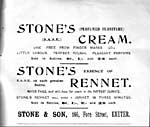 Stone's
Chemist 1902
Stone's
Chemist 1902
An advert for Stone's Chemist - from the June 1902 Exeter Coronation
Programme.
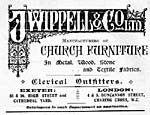 Wippell
& Co 1908
Wippell
& Co 1908
An advert for Wippell, the ecclesiastical outfitters from 1908. Apart
from their High Street premises, they had workshops in St Thomas where
they produced church furniture.
 Boon's the butchers
Boon's the butchers
A traditional butcher with sides of meat hanging in the open shop front
- modern regulations would not allow this now. These premises were near
Eastgate.
 Willey's Weekly 1903
Willey's Weekly 1903
This is
issue 8 from 23 July of Willey's Weekly, published for their workers,
and anyone else who cared to purchase it at a cost of 1d. Not only did
the paper print news of the company, but it covered stories about new
engineering techniques and tools from around the world.
The Willey's sports teams were followed - July was in the middle
of the cricket season. The firm's first sports day was reported, with
the repertoire of the Willey's Band reproduced.
 R
D Chudley - game, poultry and pork butcher 1906
R
D Chudley - game, poultry and pork butcher 1906
Richard Dunn Chudley traded from 18 North Street in 1906 with John
Gregory White as a game dealer, poulterer and pork butcher.
 W Brock
& Co furniture
W Brock
& Co furniture
Brocks offered house removals, estate agency services, funeral
arrangements, upholstery and sold furniture.
Around and About Exeter in the 1900's
 The
old Exe Bridge 1903
The
old Exe Bridge 1903
The Georgian Exe Bridge - built in 1778 to replace the medieval bridge.
The first traffic to cross this bridge was a funeral cortège. It
was demolished in 1903. Also see History of the Exe Bridges

 The new Exe Bridge
1905
The new Exe Bridge
1905
The replacement steel bridge, was opened in 1905. The photo shows the
flags and bunting at the opening. Behind can be seen the temporary
wooden bridge that was shortly demolished. The new bridge was flat, to
allow the new electric trams to pass over. Designed by Sir John Wolf
Barry, the bridge was a three hinge cantilever design. Also see History of the Exe
Bridges
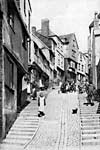
 Stepcote
Hill 1905
Stepcote
Hill 1905
Probably photographed about 1905, this image is from a postcard.
Stepcote Hill was once the main route into the
city from the Exe Bridge, and was originally part of a Roamn road that
led from the crossing over the Exe. This may be a Sunday, judging by
the number
of children and the well dressed man with the umbrella. Also see Stepcote
Hill - detail right.
 Merchants
House, West Street
Merchants
House, West Street
The shop at the bottom of Stepcote Hill. On the opposite corner (left)
is St Mary Steps Church. Properties to the right were owned by E Pearse
and Co, rag, bone and skin merchants. They traded until the 1980s when
their premises became a Porsche dealership!
 West
Street
West
Street
Looking up West Street - the 'House That Moved' has not yet
moved... Stepcote
Hill is between the church and the house/shop to the right. The
small lane to the left of West Street, between the houses is Rackclose
Lane. Also see the House that Moved
 Exeter City Football Team 1904/5 Exeter City was formed in 1904 by the amalgamation of St
Sidwell's and Exeter United. The new team played at the old United
ground of St James' Park in green and white. The photo shows the 1904/5
side. See Exeter
City FC
Exeter City Football Team 1904/5 Exeter City was formed in 1904 by the amalgamation of St
Sidwell's and Exeter United. The new team played at the old United
ground of St James' Park in green and white. The photo shows the 1904/5
side. See Exeter
City FC
 The
Eastgate Arcade
The
Eastgate Arcade
The Eastgate Arcade was situated almost opposite New
London Inn Square. It would be directly opposite the modern Boots.
Also see Eastgate Arcade
 The Guildhall 1906
The Guildhall 1906
The Guildhall in 1906 - in medieval times, stocks were set up between
the columns. The building also served as a police station, gaol and a
court. Also see Guildhall - High Street

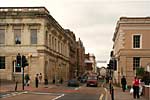 Queen Street
Queen Street
Photographed in 1908 and 2005, looking towards the High Street.
Northernhay Gardens is left and Northernhay Street on the right. Also
see Queen
Street
 The Canal Basin
The Canal Basin
The Canal
Basin, built by James Green, around about 1905. Exeter
still has some maritime trade at this time.
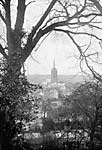 St
Sidwell's Church 1900
St
Sidwell's Church 1900
St Sidwells Church from Northernhay Park, overlooking
New North Road - circa 1900. St Sidwells was probably Exeters most
important church outside of the city walls. For more see St
Sidwell's Church
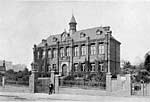 Bishop
Blackall School
Bishop
Blackall School
The Girls' Middle School, Pennsylvania Road - circa 1900. This school
became Bishop Blackall School. It is now an annexe of Exeter College.
Also see history of Bishop Blackall School and St
Peter's High School
│ Top of Page │